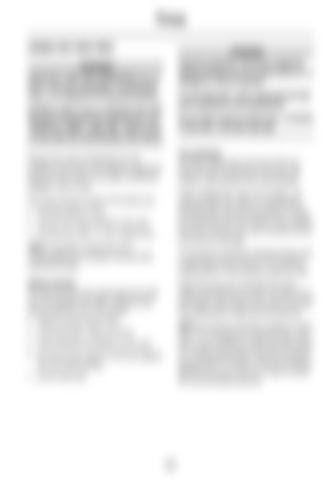Tires CARING FOR YOUR TIRES Tires
WARNING Avoid tire spinning. The forces created by rapidly spinning a tire can cause failure of, or damage to, the tire structure.
WARNING DEFECTIVE TIRES ARE DANGEROUS! Do not drive if any tire is damaged, is excessively worn, or is inflated to an incorrect pressure.
If a tire does spin, never exceed the 35 mph point indicated on the speedometer.
ALWAYS replace worn or defective tires with the factory recommended specification (see ‘WHEELS & TIRES’, page 276). Failure to do so may affect the safe handling of the vehicle.
Do not allow anyone to stand near, or directly in line with, a tire that may spin.
Tire pressures Correctly inflated tires will ensure that you enjoy the best combination of tire life, ride comfort, fuel economy and road handling.
Always drive with consideration for the condition of the tires, and regularly inspect the tread and side walls for any sign of distortion (bulges), cuts or wear.
Under-inflated tires wear more rapidly, can seriously affect the vehicle's road handling characteristics and fuel consumption, as well as increase the risk of tire failure. Over-inflated tires give a harsher ride, wear unevenly and are more prone to damage.
The most common causes of tire failure are: • Bumping against curbs • Driving over deep potholes in the road. • Driving with under- or over-inflated tires NOTE: If possible, protect tires from contamination by oil, grease, fuel and other automotive fluids.
Tire pressures should be checked at least once a week with normal road use, but should be checked DAILY if the vehicle is used off-road.
Safety practices The way you drive has a great deal to do with your tire mileage and safety. Cultivate good driving habits for your own benefit. • Observe posted speed limits
Check the pressures (including the spare wheel) when the tires are cold - be aware that it only takes 3 miles (5 km) of driving to warm the tires sufficiently to affect the tire pressures. NOTE: Air pressure naturally increases in warm tires. If it is necessary to check the tires when they are warm (after the vehicle has been driven for a while), the pressure may have increased by up to 6 lbf/in2 (41 kPa). In this circumstance, NEVER let air out of the tire in order to match the recommended pressures.
• Avoid fast starts, stops and turns • Avoid potholes and objects on the road • Do not run over curbs or hit the tire against the curb when parking • Avoid wheel spin
217



